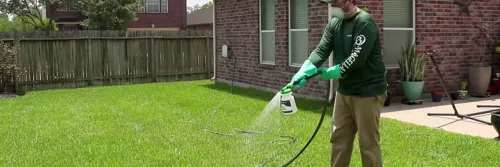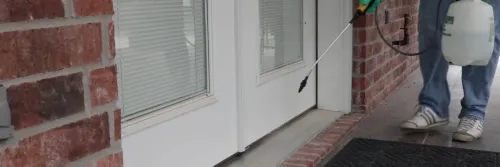how to get rid of tree frogs
Frog Control: How to Get Rid Of Frogs
This page is an expert guide on getting rid of Frogs from your property using the products and methods suggested by our experienced pest control specialists. Follow this guide and use the recommended products and we guarantee you will eliminate Frog activity around your home.
Frogs may look great in their own natural habitat jumping on lily pads and eating flies, but not when they are in the backyard. The most irritating part of having frogs around is their loud croaking right outside your bedroom, that makes you compromise on your good night's sleep.
Whether you are seeing one frog hopping around or more than a few, it is usually an indication that you need to conduct some insect control in and around your home. As such, this treatment guide for frog control will focus on getting rid of insects on your property with professional-grade pesticides. If you get rid of the frog's food source, they will move on from your property.
If you want to control the frog population around your property, follow our DIY treatment guide below to learn more about frogs and the best way to drive them out of your yard using professional techniques and control products.
Identification

Before you can carry out a control program, make sure that you are certain you are dealing with a Frog, and not some other creature. Misidentification can lead to using the wrong treatment approach, which in turn will cost you time and money.
- Frogs are small amphibians that have moist, slimy skin, bulging eyes, and powerful webbed back legs that they use to jump and hop around.
- There are nearly 5,000 different species of frog that have been discovered of all different shapes, colors and sizes. Some have poisonous skin to ward off predators.
- While they do come in a variety of colors and patterns, the average frog has green or brown skin which helps to blend into the natural environment.
- Frogs are also known for their unique ability to eat bugs by sticking their tongues out quickly to snatch a bug and yank them into their mouths. Common insects that frogs will feed on are flies, crickets, and even cockroaches.
- Another notable trait is the croaking sound they make when they are wanting to mate. Frogs are often confused with Toads. While they can appear similar, toads prefer areas that are dry while Frogs like to be around moisture.
Use the description and image above to identify Frogs on your property. If you are not totally sure, contact us and we may be able to help you correctly identify the pest.
Inspection

After you have positively confirmed that you are dealing with Frogs, proceed with the inspection. You will need to pinpoint the areas where Frogs are active and observe the conducive conditions that is drawing Frogs to your home.
Where to Inspect
Frogs outdoors thrive in areas where there is moisture and plenty of bugs to eat. You may find them around ponds, in gardens, tall grass, or where there is lots of leaf litter. They can especially be in an area after rainfall when it is still wet.
What To Look For
Look for frogs themselves that may be hopping around the perimeter of your home. You could also listen for their croaking. Check for areas where there is standing water as this can attract mosquitoes, which in turn, will attract frogs since they like to eat them. If you have lights on at night, these may also attract bugs as well as the frogs that want to feast upon them.
Treatment
Before applying any chemicals, please make sure you have on the proper PPE for safety in the form of gloves, a protective mask, and safety glasses.
To address Frogs around your home, you will need to address the issue of insects. Reducing the insect population will reduce the activity and presence of Frogs.
Step 1 - Apply Bifen LP Granules

Bifen LP is a great granular insecticide that will control around 20 different common turf pests for up to 90 days. These granules will significantly reduce the presence of insects, taking away food for the Frog and as a result, their desire to hang around your yard.
Bifen LP will need to be applied as both a broadcast treatment. To use Bifen LP, you will need a granular spreader.
First, determine how much Bifen LP you will need by calculating the square footage of your treatment area. To do this, multiply the area's length in feet and width in feet (length x width = square feet). The labeled rate for Bifen LP can vary depending on your targeted pest, from 1.15 to 4.6 pounds per 1,000 square feet. For most general applications, we recommend 2.3 pounds of Bifen LP per 1,000 square feet.
Measure out the amount of Bifen LP required for your treatment area. It is helpful to use a bucket and scale to measure the amount in pounds, and then pour it into your spreader.
Broadcast the granules over the yard making sure to apply in mulch areas, and in landscaping, and at the foot of ornamentals.
Step 2 - Spray Reclaim IT around your Yard and Perimeter.

Reclaim IT is a broad-spectrum insecticide that is labeled for treating over 70 different common pests. It also has a long residual effect that continues to kill for up to 90 days after application.
Measure the square footage of your lawn to determine how much Reclaim IT you need to cover the entire area. To apply Reclaim IT, simply mix water in a hand pump or hose-end sprayer then add Reclaim IT at a rate of 1 oz per gallon to cover 1,000 sq. ft. To accomplish uniform control when applying to dense grass foliage, use volumes of up to 10 gallons per 1,000 sq. ft. Shake well and pump your sprayer.
Broadcast the Reclaim IT mixture to activate the Bifen LP Granules and spray your entire yard and garden as opposed to spot treating. Use a fan spray setting to get nice uniform coverage.
Next, you should spray a perimeter treatment of Reclaim around the outside of your home and structure to create a barrier that will keep bugs out. Spray around doors and windows, around the foundation going up 2 or 3 feet then spray any other possible points of entry.
The application of both Bifen LP and Reclaim IT will ensure that you have treated most common crawling and flying insect pests found in residential lawns. By eliminating the frog's food source, you will effectively get rid of frogs without directly harming them.
Prevention

To keep Frogs from becoming a regular occurrence on your property, you will need to carry out IPM practices that will make your yard and home less conducive to Frogs wanting to gather. Turn off the backyard lights at night as light attracts bugs and bugs appeal to frogs.
Frogs like areas that are moist as they make nice wet hiding places to reside in and wait around for bugs.if your backyard has some pool or pond, that is basically the main attraction for frogs. By addressing water drainage issues, clearing out standing water areas and keeping your yard nice and dry. You should also mow your lawn short and remove weeds as well as leaf litter, taking away prime hiding spots. Frogs will eventually move on elsewhere.
Finally, you should spray a quarterly treatment of Reclaim IT around your perimeter as a barrier to continue to control the insects that attract Frogs to your yard and home.
Key Takeaways
What Are Frogs?
- Frogs are small amphibious creatures that are known for their characteristics of hopping around, making croaking noises, slimy skin, and a long tongue.
- Frog encounters around your home are usually the sign of an insect problem in your yard that needs to be addressed.
How To Get Rid of Frogs
- Reduce the insect population by applying Reclaim IT Insecticide and Bifen LP Granules and, as a result, Frogs will leave your yard to search for food elsewhere.
Preventing Frog Reinfestation
- IPM practices like reducing areas of moisture, shutting off outdoor lights, trimming the lawn short and reducing leaf litter can prevent Frogs from returning to your yard.
how to get rid of tree frogs
Source: https://www.solutionsstores.com/how-to-get-rid-of-frogs
Posted by: sebringlour1993.blogspot.com

0 Response to "how to get rid of tree frogs"
Post a Comment